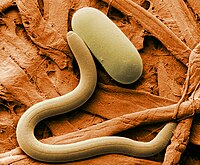
Photo from wikipedia
The soybean cyst nematode (SCN), Heterodera glycines Ichinohe, is the most damaging pathogen of soybean (Glycine max (L.) Merr.), causing more than $1 billion in yield losses annually in the… Click to show full abstract
The soybean cyst nematode (SCN), Heterodera glycines Ichinohe, is the most damaging pathogen of soybean (Glycine max (L.) Merr.), causing more than $1 billion in yield losses annually in the United States (Allen et al. 2017). The SCN distribution map updated in 2014 showed that SCN were detected in all major soybean-producing states in the U.S. except West Virginia and New York (Tylka and Marett 2014). Soybean shows great economic promise in NY and its production area in the region has been expanding rapidly. In coordination with a statewide soybean disease survey, soil samples have been collected from seventeen counties throughout NY since 2013 to search for the presence of SCN. A post-harvest soil sample collected in the fall of 2016 from a soybean field in Cayuga County, NY, was processed using the sugar centrifugal-flotation method to extract nematodes and a few brown and lemon-shaped cysts, similar to those of SCN, were isolated. The lemon-shaped cysts were light to dark brown and had a zigzag patter...
Journal Title: Plant Disease
Year Published: 2017
Link to full text (if available)
Share on Social Media: Sign Up to like & get
recommendations!